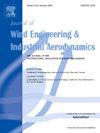Research on wind-induced bending-torsion coupling vibration mechanism and pneumatic vibration reducing measures of large-span flexible photovoltaic arrays under 0° incoming flows
IF 4.9
2区 工程技术
Q1 ENGINEERING, CIVIL
Journal of Wind Engineering and Industrial Aerodynamics
Pub Date : 2025-05-03
DOI:10.1016/j.jweia.2025.106124
引用次数: 0
Abstract
Inter-span series connection and inter-row parallel connection are important connection modes to guarantee the overall stability of large-span flexible photovoltaic arrays. However, the array structure is easy to suffer bending-torsion coupling instability vibration under the maximum thrust of 0° incoming flows. In particular, the first row of photovoltaic suffers the most significant wind load and wind-induced vibration. Therefore, it has important engineering application values to study wind-induced bending-torsion coupling vibration mechanism and vibration damping technology of the large-span flexible photovoltaic arrays under the 0° incoming flows. Firstly, a five-row and three-span complete aeroelastic model that can measure displacement of photovoltaic plates was designed and manufactured. Secondly, a 3D noncontact real-time multipoint vibration measurement technology is proposed to study the wind-induced bending-torsion coupling vibration of flexible photovoltaic arrays at varying wind speeds. Later, four new pneumatic spoiler devices were put forward. The pneumatic vibration damping effect was analyzed by the complete ensemble empirical mode decomposition with adaptive noise (CEEMDAN) and frequency slice wavelet transform(FSWT). Research results demonstrate that: the bending-torsion coupling vibration of the flexible photovoltaic arrays with wind speed under 0° incoming flows changes from the high-order torsion mode and low-order vertical bending mode to low-order bending-torsion coupling mode. When the wind speed is higher 30.36 m/s, the structure begins to produce vertical bending-torsion coupling vibration and frequency-doubled effect, showing significant nonlinear features. Based on static wind displacement response and time-frequency energy distribution of the structure, it found from a comparison that the “>-shaped” spoiler device has the optimal vibration inhibition effect and the maximum vibration inhibition rate is 75.4 %. The “<-shaped” spoiler device has the second vibration inhabitation effect, while the “L-shaped” and “Γ-shaped” devices show the poorest effect and the minimum vibration inhibition rate is 62.3 %.
0°气流下大跨度柔性光伏阵列风致弯扭耦合振动机理及气动减振措施研究
跨间串联和行间并联是保证大跨度柔性光伏阵列整体稳定性的重要连接方式。然而,在0°来流最大推力下,阵列结构容易遭受弯曲-扭转耦合不稳定振动。其中,第一排光伏板承受的风荷载和风致振动最为显著。因此,研究0°来流下大跨度柔性光伏阵列的风致弯扭耦合振动机理和减振技术具有重要的工程应用价值。首先,设计并制作了一个能够测量光伏板位移的五排三跨全气动弹性模型。其次,提出了一种三维非接触实时多点振动测量技术,研究了柔性光伏阵列在不同风速下的风致弯扭耦合振动。随后,又提出了四种新型气动扰流装置。采用自适应噪声全系综经验模态分解(CEEMDAN)和频片小波变换(FSWT)对气动减振效果进行了分析。研究结果表明:在0°来流条件下,风速下柔性光伏阵列的弯扭耦合振动由高阶扭转模式和低阶垂直弯曲模式转变为低阶弯扭耦合模式。当风速高于30.36 m/s时,结构开始产生垂直弯扭耦合振动和倍频效应,表现出明显的非线性特征。基于静力风位移响应和结构时频能量分布对比发现,“>;”型扰流片的减振效果最佳,最大减振率为75.4%。“<;”型阻振装置的抑振效果次之,“l”型阻振装置和“Γ-shaped”型阻振装置的抑振效果最差,抑振率最低,为62.3%。
本文章由计算机程序翻译,如有差异,请以英文原文为准。
求助全文
约1分钟内获得全文
求助全文
来源期刊
CiteScore
8.90
自引率
22.90%
发文量
306
审稿时长
4.4 months
期刊介绍:
The objective of the journal is to provide a means for the publication and interchange of information, on an international basis, on all those aspects of wind engineering that are included in the activities of the International Association for Wind Engineering http://www.iawe.org/. These are: social and economic impact of wind effects; wind characteristics and structure, local wind environments, wind loads and structural response, diffusion, pollutant dispersion and matter transport, wind effects on building heat loss and ventilation, wind effects on transport systems, aerodynamic aspects of wind energy generation, and codification of wind effects.
Papers on these subjects describing full-scale measurements, wind-tunnel simulation studies, computational or theoretical methods are published, as well as papers dealing with the development of techniques and apparatus for wind engineering experiments.

 求助内容:
求助内容: 应助结果提醒方式:
应助结果提醒方式:


